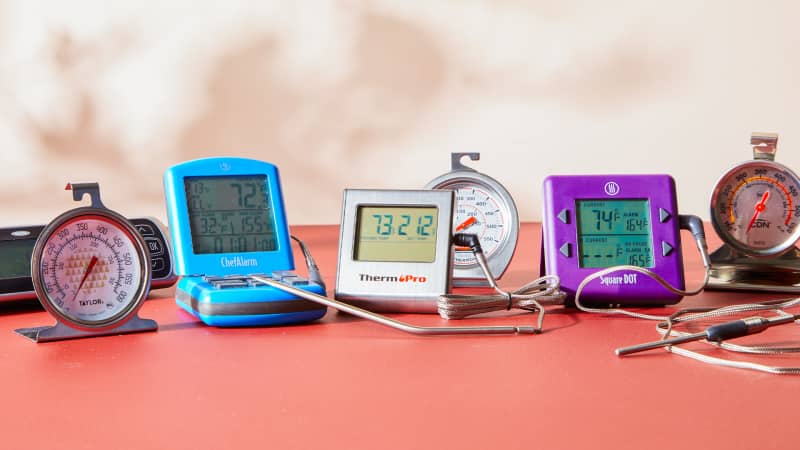The Best Instant-Read Thermometers
Equipment Review
An oven thermometer is the only reliable way to know what’s happening inside your oven—unless you have a model that’s inaccurate, hard to read, or falls off the racks.
Last Updated Mar. 14, 2024. Appears in America's Test Kitchen TV Season 21: Schnitzel and Roesti

We've incorporated digital oven thermometers into our rankings. Our favorite analog oven thermometer remains the CDN DOT2 - Oven Thermometer. Our favorite digital versions are the ThermoWorks Square DOT and the ThermoPro TP16.
The best oven thermometers are accurate and easy to use, letting you know if your oven temperatures are significantly off. In general, we prefer digital thermometers, as they are more precise and durable and can be used for other tasks besides taking oven temperatures. Our favorite is the ThermoWorks Square DOT; it’s especially easy to operate and has two probes, making it especially handy for tracking food and air temperatures. A less expensive digital option is the ThermoPro TP16; it’s got a few operational quirks but is impressively accurate. Conventional analog oven thermometers are still the cheapest way to check your oven temperatures. Our favorite is the CDN DOT2 - Oven Thermometer. It was consistently accurate and easy to read.
What You Need to Know
Does your soufflé fail to puff up to the tallest heights? Do your cookies brown too quickly—or spread out too much before they brown at all? Does the outside of your roast beef overcook before the inside comes up to temperature? If you’ve had any of these cooking or baking headaches, your oven might be to blame.
A good oven thermometer lets you test the accuracy of your oven’s temperature settings so that you can adjust them as needed. If the thermometer shows that your oven runs hot, you’ll want to decrease the temperature setting accordingly on your next oven foray. If it runs cold, you’ll increase that temperature.
How Do I Know If My Oven Temperatures Are Accurate?
In order to know what accuracy means for an oven, it’s important to understand a few things about how ovens work. First, you can’t always trust your oven to tell you when it’s ready—alerts are not always accurate. An oven’s internal thermometer only gauges the temperature of the location where it’s installed, which is necessarily in an out-of-the-way spot in the back, front, or side of the oven box. The trouble is, these areas don’t necessarily reflect the temperature at the center of the oven, where food cooks.
Second: Ovens don’t stay at the exact temperature you set for hours at a time. Instead, they cycle up and down through a range of temperatures around the target temperature. A well-calibrated oven can cycle through temperatures that are as much as 25 degrees above and below that target temperature. Over time, however, the temperature should average out to the one you’ve set.
But even ovens that aren’t perfectly calibrated can still work just fine. With most foods, you won’t notice even if your average oven temperature is off by as much as 25 degrees. Your cake or roast beef or potatoes will still be delicious and the cook time won’t be radically different from the ones you see i...

The mission of America’s Test Kitchen Reviews is to find the best equipment and ingredients for the home cook through rigorous, hands-on testing. We stand behind our winners so much that we even put our seal of approval on them.

Kate is a deputy editor for ATK Reviews. She's a culinary school graduate and former line cook and cheesemonger.

Miye is a senior editor for ATK Reviews. She covers booze, blades, and gadgets of questionable value.

This is a members' feature.